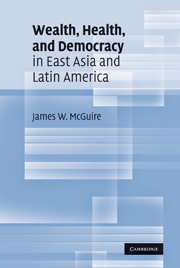Book contents
- Frontmatter
- Contents
- Figures and Tables
- Preface and Acknowledgments
- Abbreviations
- 1 Incomes, Capabilities, and Mortality Decline
- 2 Democracy, Spending, Services, and Survival
- 3 Costa Rica: A Healthy Democracy
- 4 Chile: The Pinochet Paradox
- 5 Argentina: Big Welfare State, Slow Infant Mortality Decline
- 6 Brazil: From Laggard to Leader in Basic Health Service Provision
- 7 Taiwan: From Poor but Healthy to Wealthy and Healthy
- 8 South Korea: Small Welfare State, Fast Infant Mortality Decline
- 9 Thailand: Democratization Speeds Infant Mortality Decline
- 10 Indonesia: Authoritarianism Slows Infant Mortality Decline
- 11 Wealth, Health, Democracy, and Mortality
- Appendix Tables
- Works Cited
- Index
9 - Thailand: Democratization Speeds Infant Mortality Decline
Published online by Cambridge University Press: 06 July 2010
- Frontmatter
- Contents
- Figures and Tables
- Preface and Acknowledgments
- Abbreviations
- 1 Incomes, Capabilities, and Mortality Decline
- 2 Democracy, Spending, Services, and Survival
- 3 Costa Rica: A Healthy Democracy
- 4 Chile: The Pinochet Paradox
- 5 Argentina: Big Welfare State, Slow Infant Mortality Decline
- 6 Brazil: From Laggard to Leader in Basic Health Service Provision
- 7 Taiwan: From Poor but Healthy to Wealthy and Healthy
- 8 South Korea: Small Welfare State, Fast Infant Mortality Decline
- 9 Thailand: Democratization Speeds Infant Mortality Decline
- 10 Indonesia: Authoritarianism Slows Infant Mortality Decline
- 11 Wealth, Health, Democracy, and Mortality
- Appendix Tables
- Works Cited
- Index
Summary
Thailand from 1960 to 2005 achieved fast economic growth and a rapid decline of income poverty. It also did well at raising educational attainment, improving family planning, expanding access to safe water and adequate sanitation, and delivering basic health services and nutritional assistance to the poor. Not surprisingly, then, Thailand from 1960 to 2005 had one of the steepest infant mortality declines in the world, ranking by one measure eighth of 140 countries for which data are available. At older ages, however, the spread of HIV infection and AIDS deaths from the mid-1980s onward caused the risk of dying between ages 15 and 60 to rise sharply (few AIDS deaths occur among infants, so the epidemic had only a small direct effect on infant mortality). Mainly as a result of these AIDS deaths, Thailand's level of life expectancy in 2005, as well as its percent rise of life expectancy from 1960 to 2005, ranked below the median of the world's countries. A broad consensus exists, however, that Thailand's policies to fight HIV/AIDS were among the most successful in the world. By 2000 the rate of adult mortality had begun to fall again.
Because Thailand from 1960 to 2005 achieved one of the world's fastest rates of economic growth and income poverty decline, it is tempting to attribute its success at reducing infant mortality mainly to economic factors. Thailand, however, did even better at reducing infant mortality, and at achieving a low level of infant mortality, than its strong performance on GDP per capita predicted (Figures 1.1 and 1.2).
- Type
- Chapter
- Information
- Wealth, Health, and Democracy in East Asia and Latin America , pp. 228 - 253Publisher: Cambridge University PressPrint publication year: 2010
- 1
- Cited by



